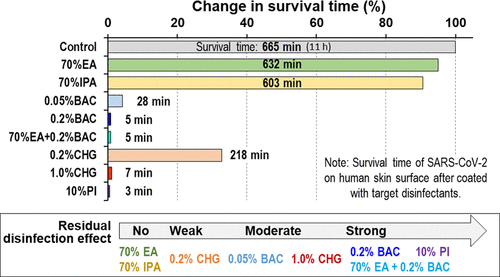当前位置:
X-MOL 学术
›
Environ. Sci. Technol.
›
论文详情
Our official English website, www.x-mol.net, welcomes your
feedback! (Note: you will need to create a separate account there.)
Evaluation of the Residual Disinfection Effects of Commonly Used Skin Disinfectants against Viruses: An Innovative Contact Transmission Control Method
Environmental Science & Technology ( IF 10.8 ) Pub Date : 2021-11-28 , DOI: 10.1021/acs.est.1c05296 Ryohei Hirose 1, 2 , Yoshito Itoh 2 , Hiroshi Ikegaya 3 , Hajime Miyazaki 1, 2 , Naoto Watanabe 1, 2 , Takuma Yoshida 1, 2 , Risa Bandou 1, 3 , Tomo Daidoji 1 , Takaaki Nakaya 1
Environmental Science & Technology ( IF 10.8 ) Pub Date : 2021-11-28 , DOI: 10.1021/acs.est.1c05296 Ryohei Hirose 1, 2 , Yoshito Itoh 2 , Hiroshi Ikegaya 3 , Hajime Miyazaki 1, 2 , Naoto Watanabe 1, 2 , Takuma Yoshida 1, 2 , Risa Bandou 1, 3 , Tomo Daidoji 1 , Takaaki Nakaya 1
Affiliation

|
Lasting disinfection effects, that is, the residual disinfection effects (RDEs), of skin-coated disinfectants have rarely been considered for infection control owing to the challenges involved in the accurate evaluation of RDEs. In this study, we constructed a new skin evaluation model and determined the RDEs of existing disinfectants against viruses. Our results showed that ethanol and isopropanol had no RDE, whereas povidone–iodine, chlorhexidine gluconate, and benzalkonium chloride (BAC) exhibited RDEs, with 10% povidone–iodine and 0.2% BAC showing particularly strong RDEs. The RDE of 0.2% BAC was strong enough to reduce the median survival times of severe acute respiratory syndrome coronavirus-2, human coronavirus-OC43, and influenza virus from 670 to 5.2, 1300 to 12, and 120 to 4.2 min, respectively. Additionally, this strong RDE was maintained even 4 h after coating the skin. Clinical data also showed that the strong RDE of 0.2% BAC was maintained for more than 2 h. Thus, applying disinfectants with strong RDEs on the skin correlates with a reduction in virus survival time and appears to create a skin surface environment that is not conducive to virus survival. A prolonged reduction in virus survival decreases the contact transmission risk, thereby enabling stronger infection control.
中文翻译:

常用皮肤消毒剂对病毒的残留消毒效果评价:一种创新的接触传播控制方法
由于准确评估 RDE 所涉及的挑战,皮肤涂层消毒剂的持久消毒效果,即残留消毒效果 (RDE) 很少被考虑用于感染控制。在这项研究中,我们构建了一个新的皮肤评估模型,并确定了现有消毒剂对病毒的 RDE。我们的结果表明乙醇和异丙醇没有 RDE,而聚维酮碘、葡萄糖酸氯己定和苯扎氯铵 (BAC) 表现出 RDE,10% 聚维酮碘和 0.2% BAC 表现出特别强的 RDE。0.2% BAC 的 RDE 足以将严重急性呼吸系统综合症冠状病毒-2、人类冠状病毒-OC43 和流感病毒的中位生存时间分别从 670 分钟降至 5.2、1300 至 12 分钟和 120 至 4.2 分钟。此外,即使在涂上皮肤 4 小时后,这种强 RDE 仍能保持。临床数据还显示,0.2% BAC 的强 RDE 可维持 2 小时以上。因此,在皮肤上使用具有强 RDE 的消毒剂与病毒存活时间的减少相关,并且似乎创造了不利于病毒存活的皮肤表面环境。病毒存活率的长期降低降低了接触传播的风险,从而能够加强感染控制。
更新日期:2021-12-07
中文翻译:

常用皮肤消毒剂对病毒的残留消毒效果评价:一种创新的接触传播控制方法
由于准确评估 RDE 所涉及的挑战,皮肤涂层消毒剂的持久消毒效果,即残留消毒效果 (RDE) 很少被考虑用于感染控制。在这项研究中,我们构建了一个新的皮肤评估模型,并确定了现有消毒剂对病毒的 RDE。我们的结果表明乙醇和异丙醇没有 RDE,而聚维酮碘、葡萄糖酸氯己定和苯扎氯铵 (BAC) 表现出 RDE,10% 聚维酮碘和 0.2% BAC 表现出特别强的 RDE。0.2% BAC 的 RDE 足以将严重急性呼吸系统综合症冠状病毒-2、人类冠状病毒-OC43 和流感病毒的中位生存时间分别从 670 分钟降至 5.2、1300 至 12 分钟和 120 至 4.2 分钟。此外,即使在涂上皮肤 4 小时后,这种强 RDE 仍能保持。临床数据还显示,0.2% BAC 的强 RDE 可维持 2 小时以上。因此,在皮肤上使用具有强 RDE 的消毒剂与病毒存活时间的减少相关,并且似乎创造了不利于病毒存活的皮肤表面环境。病毒存活率的长期降低降低了接触传播的风险,从而能够加强感染控制。











































 京公网安备 11010802027423号
京公网安备 11010802027423号